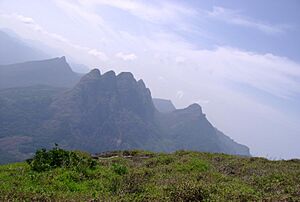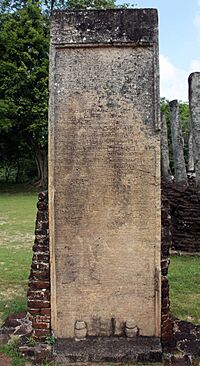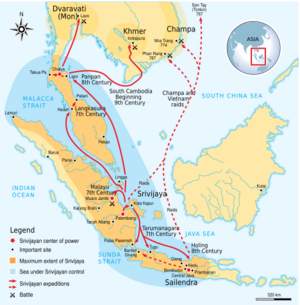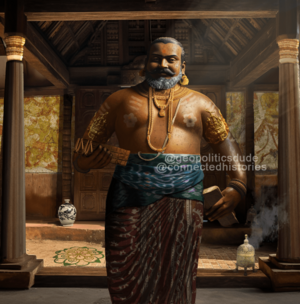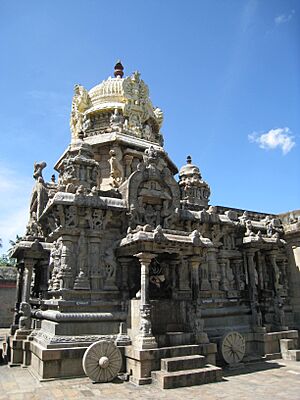Kulottunga I facts for kids
Quick facts for kids Kulottunga I |
|||||
|---|---|---|---|---|---|
| Rajakesarivarman, Chakravarti, Rajanarayana, Tribhuvana Chakravarti, Konerinmaikondaan, Sungam Thavirtha Cholan, Jayadhara, Virudarajabhayankara | |||||

Sculpture of Kulottunga I at Nataraja Temple.
|
|||||
| Chola Emperor | |||||
| Reign | c. June 1070 – c. 1122 | ||||
| Predecessor | Athirajendra | ||||
| Successor | Vikrama | ||||
| Eastern Chalukya Emperor | |||||
| Reign | c. 1061 – c. 1118 | ||||
| Predecessor | Rajaraja Narendra | ||||
| Successor | Vikramaditya VI | ||||
| King of Kadaram | |||||
| Reign | c. 1070 | ||||
| Predecessor | Athirajendra | ||||
| Successor | Position abolished (Tribhuwanaraja as King of Melayu) |
||||
|
|||||
| Reign | c. 1070 (few months) | ||||
| Predecessor | Athirajendra | ||||
| Successor | Vijayabahu I | ||||
| Born | Rajendra Chalukya 1025 Chelluru, Vengi, Chola Empire ( modern day Rayavaram, Andhra Pradesh, India) |
||||
| Died | 1122 (aged 96–97) Gangaikonda Cholapuram, Chola Empire (modern day Jayankondam, Tamil Nadu, India) |
||||
| Queen | DinaChintamani Madurantaki Thyagavalli Elisai Vallabhi Solakulavalliyār |
||||
| Issue |
|
||||
|
|||||
| Dynasty | Chola (mother's side) Eastern Chalukya (father's side) |
||||
| Father | Rajaraja Narendra | ||||
| Mother | Amangai Devi | ||||
| Religion | Hinduism | ||||
| Signature | |||||
Kulottunga Chola I (1025–1122), also known as Rajendra Chalukya, was a powerful Chola Emperor. He ruled from 1070 to 1122. He became emperor after his cousin, Athirajendra Chola.
Kulottunga was special because he was related to two major dynasties. His mother, Ammangaidevi, was a Chola princess. His father, Rajaraja Narendra, was king of the Eastern Chalukyas. This connection helped him bring peace and good rule to the empire.
During his long reign, Kulottunga had friendly relations with many countries. These included Cambodia, Srivijaya (in Southeast Asia), Burma, and China. He also made sure the Chola Empire controlled the Srivijayan area of Kedah. A famous Tamil poem, Kalingattuparani, was written in his court. He was also known for his excellent system of collecting taxes and managing local areas. He even ordered a huge survey of land to help with taxes.
Kulottunga died around 1122, possibly at a very old age for his time. His son, Vikrama Chola, took over the throne. Historians say he avoided unnecessary wars and truly cared for his people. His rule was successful and helped the empire stay strong for many years.
Contents
Early Life and Family Connections
Kulottunga was born around 1025. We know about his family from old records and poems. His mother, Ammangadevi, was the daughter of the great Emperor Rajendra Chola I. This made Kulottunga the grandson of a very important Chola ruler.
His father was King Rajaraja Narendra of the Eastern Chalukya dynasty. Rajaraja Narendra was also related to the Cholas through his mother. This meant Kulottunga had strong family ties to both the Chola and Eastern Chalukya royal families.
As a young prince, Kulottunga was a skilled warrior. He helped his maternal uncle, Emperor Virarajendra Chola, in battles. He conquered areas like Kedah in Southeast Asia and Chakrakota in India. These early victories showed his strength and leadership.
Becoming Emperor
Kulottunga grew up in the Chola capital, Gangaikondacholapuram. He fought in many wars alongside Chola emperors like Rajendra Chola I and Virarajendra Chola. He gained victories in northern campaigns, proving his skills in battle.
After Virarajendra Chola died, there was some confusion in the Chola kingdom. The next king, Athirajendra Chola, died suddenly. This caused a period of disorder in the empire. Kulottunga returned and brought stability back.
Old records say that Kulottunga was first crowned as the ruler of Vengi. Later, he became the emperor of the Chola kingdom in 1070. He claimed that he rightfully inherited the Chola throne. He wanted to prevent other kingdoms from interfering in Chola affairs. Kulottunga quickly took control and secured the empire.
Military Campaigns and Conflicts
Kulottunga was a strong military leader. He fought to protect and expand the Chola Empire.
Battles in Northern India
Even as a prince, Kulottunga led Chola armies in northern campaigns. He fought in areas like Sakkarakottam and Vayiragaram. He defeated his enemies and captured many elephants. He also collected tribute from the king of Dhara. These victories helped him gain control over a small region north of Vengi.
Conflicts with Western Chalukyas
The Western Chalukyas were long-time rivals of the Cholas. They had fought many wars over the years. When Kulottunga became emperor, a conflict with the Western Chalukyas was expected. Their king, Vikramaditya VI, did not want the Chola and Vengi kingdoms to be united under one ruler.
Around 1075-76, the Chalukyan army attacked Chola lands. Kulottunga's forces fought back strongly in an event known as the Nangili episode. The Chola army completely defeated the Chalukyas and chased them away. Kulottunga captured many elephants and took control of two provinces, Gangamandalam and Singanam. After this, Vikramaditya VI avoided war with the Cholas for a long time.
Campaigns in Southern India
After dealing with the Western Chalukyas, Kulottunga focused on the southern regions. The Pandya country, a long-time Chola territory, had rebelled. Its rulers often caused trouble for the Chola emperors.
Kulottunga sent a large army south around 1077-1081 AD. His forces conquered the Pandya country, including the Pearl Fisheries and the Podiyil Mountains. He set the southern border of the Chola influence at Kottar. He also defeated the Chera Perumal kings who had rebelled. His general, Naralokavira Kalinga Rayan, captured the port of Quilon in Kerala.
Kulottunga changed how the southern areas were governed. Instead of appointing Chola-Pandya viceroys, he built military camps. These camps protected his interests and collected tribute. However, he allowed local chiefs to manage their own internal affairs.
Controlling Vengi
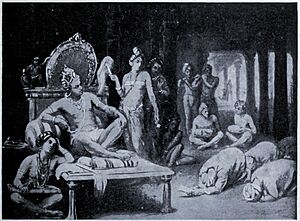
The Vengi kingdom was a disputed area between the Cholas, Western Chalukyas, and Eastern Gangas. Kulottunga's paternal uncle, Vijayaditya, ruled Vengi for a while. After Vijayaditya died in 1077, Kulottunga took direct control of Vengi.
He appointed his sons to rule Vengi as viceroys. His eldest son, Rajaraja Chodaganga, was the first viceroy. Later, his other sons, Vira Chola and Vikrama Chola, also governed the region. This showed Kulottunga's strong control over Vengi.
Wars with Kalinga
The Kalinga kingdom, located north of Vengi, often caused issues for the Chola Empire. Kulottunga's records mention two wars with Kalinga.
The first Kalinga war happened before 1096. It seems Kalinga attacked Vengi, leading to the Chola response. This war resulted in the Chola kingdom taking over the southern part of Kalinga.
The second invasion took place a few years later. It is famously described in the poem Kalingattuparani. Kulottunga's general, Karunakara Tondaiman, led this expedition. They defeated the Kalinga ruler, Anantavarman Chodaganga. The Chola army returned with a lot of treasure from this campaign. Some say the war happened because Kalinga stopped paying its yearly tribute to Kulottunga.
Losing Control of Sri Lanka
According to ancient Sri Lankan records, the Cholas were driven out of Sri Lanka around the time Kulottunga became emperor. The Sinhalese king, Vijayabahu I, took advantage of the unrest in the Chola mainland. He attacked the Chola forces on the island and defeated them.
Vijayabahu captured the Chola strongholds of Anuradhapura and Polonnaruwa. He then declared himself king of Sri Lanka. Unlike his ancestors, Kulottunga did not launch major campaigns to retake Sri Lanka. He focused on keeping the Chola Empire strong on the mainland.
Overseas Trade and Diplomacy
Kulottunga was very interested in trade with other countries. He kept strong connections with kingdoms like Srivijaya (in Southeast Asia), China, and the Khmer Empire. He even renamed the port of Visakhapattanam as Kulottungacolapattanam, showing his focus on sea trade.
In 1077, Kulottunga sent a group of traders to the Chinese court. This trip was very profitable for the Cholas. The Khmer king, Suryavarman II (who built Angkor Wat), also sent a gift to Kulottunga in 1114. The ruler of Pagan (Burma) also had contact with the Chola royal family.
There is also a belief that Kulottunga spent time in Srivijaya when he was younger. He might have helped restore order there and maintain Chola influence. These strong trade and cultural links, started by earlier Chola kings, continued under Kulottunga. In 1089, Srivijaya sent ambassadors to Kulottunga's court. They asked him to renew old grants for a Buddhist monastery in Nagapattinam.
Extent of the Empire
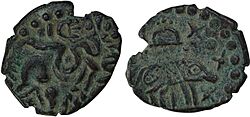
For most of Kulottunga's reign, the Chola Empire remained very strong. The Tungabhadra river continued to be the border with the Western Chalukyas. The Cholas had firm control over Vengi. They also controlled parts of Kalinga, including its capital. The port of Quilon on the Malabar Coast was also recovered.
Towards the end of his rule, some parts of the empire faced challenges. When his son, Vikrama Chola, left Vengi to become heir, the northern part of Vengi was briefly lost to the Western Chalukyas. Kulottunga also lost the Gangavadi province to the Hoysala ruler, Vishnuvardhana.
Administration and Governance
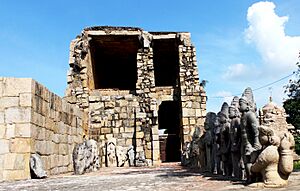

Kulottunga's capital was Gangaikondacholapuram. Kanchi was another important city, with a royal palace. His records show a very well-organized system for taxes and local government. He ordered a huge land survey to help with taxation.
He was known for promoting free trade. He removed tolls or transit duties, earning him the title "Sungamtavirrton," meaning "one who abolished tolls." In the southern regions, he changed the old system of appointing Chola-Pandya viceroys. Instead, he built military camps to protect Chola interests and collect tribute. However, he allowed local chiefs to manage the internal affairs of their territories.
Kulottunga had many skilled officials who helped him. These included generals, ministers, and accountants. They assisted him in his military campaigns and in running the empire smoothly.
Family and Personal Life
Kulottunga had several queens. His chief queen was Dinachintamani. Other queens included Elisaivallabhi and Thiyagavalli. Records mention that he had seven sons with his queen Madurantaki. Thiyagavalli became the chief queen after Dinachintamani passed away. She was said to have equal authority with the king. Another queen, Solakulavalliyār, helped renew grants for a Buddhist monastery.
Three of his sons are well-known: Rajaraja Chodaganga, Vira Chola, and Vikrama Chola. Rajaraja was the eldest. Kulottunga also had a younger sister named Rajarajan-Kundavai-Alvar. She made gifts to the Nataraja temple in Chidambaram. One of his daughters, Ammangai-Alvar, is also mentioned in later inscriptions.
Religious Views

Under Kulottunga, both Saivism (worship of Shiva) and Vaishnavism (worship of Vishnu) were encouraged. The king and his family gave gifts to the Nataraja Temple in Chidambaram. He was also accepting of other religions, like Buddhism. He renewed grants for a Buddhist monastery in Nagapattinam.
Some historians debate if he persecuted the Vaishnavite leader Ramanuja. However, Kulottunga ruled for a very long time, and some records show him giving gifts to Vishnu temples later in his reign. For example, he visited a Vishnu temple in Kanchipuram with his queens and made donations.
Art and Architecture
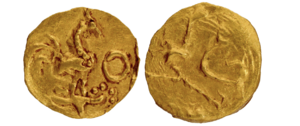
Kulottunga was a great supporter of arts and architecture. The famous poet Jayamkondar was part of his royal court. Jayamkondar wrote the well-known poem Kalingattuparani during Kulottunga's rule. Some scholars also believe that the great poet Kambar, who wrote the Ramavataram, lived during his time.
Kulottunga and his son expanded the Chidambaram Nataraja Temple significantly. The Amritaghateswarar Shiva temple in Melakadambur was also built during his reign. This temple is unique because it is shaped like a chariot with wheels, pulled by horses.
During his time, a city called Kulottunga Chozhapuram (now Thungapuram) was a center for religious activities. The city's streets were laid out in a square shape, similar to Madurai. Kulottunga built two temples there: one for Lord Shiva and another for Lord Vishnu. He also built several temples dedicated to the Sun God, inspired by his visits to the Gahadavala kingdom.
Inscriptions and Records
Kulottunga's inscriptions often begin with phrases like "pugal madu vilanga" or "pugal sunda punari." These phrases describe his victories over the Cheras, Pandyas, and Vikramaditya VI. They also tell about his early life, including his brave actions in Sakkarakottam and Vayiragaram.
In his early years, he was known as Rajakesarivarman alias Rajendracholadeva. An inscription from Kolar, dated to his second year, mentions his victories in Sakkarakottam and Vayiragaram. Another inscription from Tiruvottiyur, from his third year, also uses this title. These inscriptions show how his officers managed temples and made donations. Some places mentioned in his inscriptions were named after his predecessor, Rajadhiraja Chola I, who had captured the Western Chalukya capital.
Images for kids


